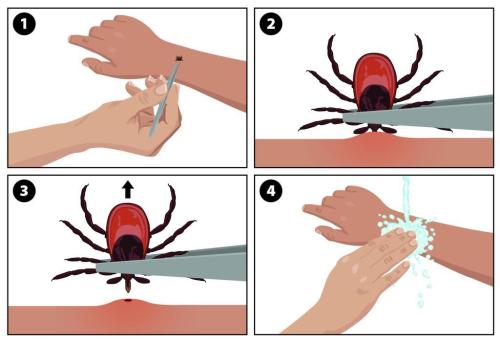Ticks are small parasites that bite and feed on the blood of people and animals. The blacklegged tick, also called the deer tick, can carry a germ called Borrelia burgdorferi, which causes Lyme disease. Lyme disease is the most common illness spread by ticks in New York and the Northeast.
Ticks become active when the temperature is above 45°F. Young ticks, called nymphs, are most active from mid-May to mid-August. Adult ticks are usually active from March to mid-May and again from mid-August to November.
Tick Bite Prevention
To prevent tick bites and reduce your risks for Lyme disease and tick-borne illnesses:
- Wear long pants and long shirts; tuck your shirt into your pants and your pants into socks
- Use insect repellent - The Environmental Protection Agency (EPA) has an online tool to help you select the repellent that is best for you and your family.
- Inspect yourself, children and pets for ticks after outdoor activities, even in your yard.
- Shower or bathe after spending time outdoors
- Walk in the center of paths to avoid brush, grass, and leaf litter
- Reduce tick habitat
- Use pesticides as indicated on their labels
- Keep pets away from brush and check them for ticks to prevent them from bringing ticks indoors.
- More Lyme Disease prevention tips from NYSDOH
How to Remove a Tick
Ticks can stay attached to your body for several days if unnoticed, which increases the risk of disease transmission. It's important to act quickly and correctly:
- Use pointed tweezers to grasp the tick by the head or mouth, not the body.
- Pull firmly and steadily, without jerking or twisting.
- Place the tick in rubbing alcohol for killing and potential identification.
- Clean the bite with rubbing alcohol or hydrogen peroxide.
- Monitor the bite for 30 days for a rash and follow the same steps for pets.

Graphic from CDC.gov - Ticks/After a tick bite
Lyme Disease and Ticks
Lyme disease is a bacterial infection which is spread by a bite from an infected blacklegged tick, which is also known as a deer tick. This tick can spread other tickborne diseases as well.
Lyme Disease Symptoms
- fever
- headache
- fatigue
How Lyme Disease is Diagnosed
- Symptoms
- Physical findings (such as a rash)
- Possibility of exposure to infected ticks
- Laboratory testing is helpful if used correctly and performed with validated methods
Lyme Disease Treatment
Most cases of Lyme disease can be treated successfully with a few weeks of prescription antibiotics. If left untreated, infection can spread to joints, the heart, and the nervous system.
Tick Testing
The Erie County Department of Health does not test ticks for disease.
Tick testing may done by the following agencies:
- Ticknology; (970) 305-5587
- TickReport; (413) 545-1057
- TickCheck; (866) 713-TICK
ECDOH does not test ticks. Even if a tick is tested and found to carry a disease, it does not necessarily mean that the disease was transmitted to the person or pet on which it was found.
This map displays the risk of encountering an infected blacklegged (deer) tick by New York geographic region: NY Tick Risk Map.
Educational Information About Ticks and Lyme Disease

Tick Identification: pictures and details on types of ticks
Tick Maps: Maps showing where ticks are found in NY State
Other Tick-Borne Illnesses
While Lyme disease is the most well-known tick-borne illness, ticks can transmit a variety of other diseases that pose serious health risks. Other tick-borne illnesses include:
- Alpha-gal allergy
- Anaplasmosis
- Babesiosis
- Ehrlichiosis
- Powassan Virus Disease
- Rocky Mountain Spotted Fever